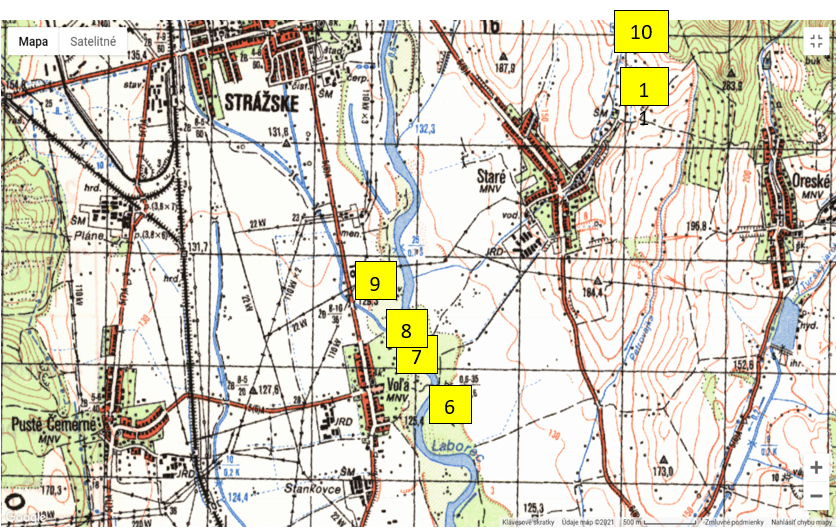FIELD WORK

On November 5, 2021, a terrain reconnaissance took place in the vicinity of the villages of Voľa and Staré - exploring suitable localities for hydrobiological monitoring with schools.
Field team: Andrej Mock, Monika Balogová, Natália Pipová, Ivana Slepáková (and a driver Marcel Kuchta), and Martin Slepák in the field discussion.
 6 - right bank of the Laborec river near the village of Voľa, access by sidewalks from the municipal office; Laborec is bordered on the right by a relatively large strip of floodplain forest and remnants of river branches. A gravel bottom and unregulated riverbed, a shallow bank with grassland separates the floodplain forest from the river; empty shell of an immature Anodonta sp., relatively fresh beaver gnaws can be seen on the opposite bank
6 - right bank of the Laborec river near the village of Voľa, access by sidewalks from the municipal office; Laborec is bordered on the right by a relatively large strip of floodplain forest and remnants of river branches. A gravel bottom and unregulated riverbed, a shallow bank with grassland separates the floodplain forest from the river; empty shell of an immature Anodonta sp., relatively fresh beaver gnaws can be seen on the opposite bank
7 - right bank of the Laborec river at the mouth of Strážsky brook, about 200 m above the previous place, floodplain forest
8 - Strážsky brook just before the mouth of the Laborec river, gravel bottom, stones covered with a dark coating, but the water is clear, smells faintly over the WWTP (wastewater treatment plants), low condition, flow interrupted to smaller lakes, small individuals of chubs (Squalius cephalus) stuck in them, zoobenthos invisible
9 - Strážsky brook by the road bridge Voľa - Strážske, muddy-sandy bottom, width of the stream about 1.5 m, depth up to 30 cm, water obviously polluted (grey coatings), animals invisible
10 - Starianka stream above the pond - above the village of Staré; occurrence of Gyrinus natator (predatory water beetles of the family Gyrinidae, characterized by rapid sliding movement on the water surface), Gammarus sp., on one section in a smaller raft, the occurrence of Scardinius erythrophthalmus (rudds), apparently navigable from the pond (it is not a species that would naturally like small watercourses). The formation of travertine and foam is visible in several places.
11 - nameless regulated left tributary of Starianka above the village, where both small streams line a field road in regulated riverbeds, observed occurrence of Chara sp.
Summary: The observed small watercourses are vigorously regulated. Straight streams apparently do not work well as habitats, they do not retain water on a slope during heavy rains. The periodically flooded part of the floodplain forest is a unique environment for the reproduction of many river animals (especially fish and insects) and there are also animals specifically associated with periodic waters, including amphibians. To begin the process of reflecting on the revitalization of the country, it is necessary to eliminate further negative interventions in the country and initiate the first steps to improve the situation.
Field team: Andrej Mock, Monika Balogová, Natália Pipová, Ivana Slepáková (and a driver Marcel Kuchta), and Martin Slepák in the field discussion.
 6 - right bank of the Laborec river near the village of Voľa, access by sidewalks from the municipal office; Laborec is bordered on the right by a relatively large strip of floodplain forest and remnants of river branches. A gravel bottom and unregulated riverbed, a shallow bank with grassland separates the floodplain forest from the river; empty shell of an immature Anodonta sp., relatively fresh beaver gnaws can be seen on the opposite bank
6 - right bank of the Laborec river near the village of Voľa, access by sidewalks from the municipal office; Laborec is bordered on the right by a relatively large strip of floodplain forest and remnants of river branches. A gravel bottom and unregulated riverbed, a shallow bank with grassland separates the floodplain forest from the river; empty shell of an immature Anodonta sp., relatively fresh beaver gnaws can be seen on the opposite bank 7 - right bank of the Laborec river at the mouth of Strážsky brook, about 200 m above the previous place, floodplain forest
8 - Strážsky brook just before the mouth of the Laborec river, gravel bottom, stones covered with a dark coating, but the water is clear, smells faintly over the WWTP (wastewater treatment plants), low condition, flow interrupted to smaller lakes, small individuals of chubs (Squalius cephalus) stuck in them, zoobenthos invisible
9 - Strážsky brook by the road bridge Voľa - Strážske, muddy-sandy bottom, width of the stream about 1.5 m, depth up to 30 cm, water obviously polluted (grey coatings), animals invisible
10 - Starianka stream above the pond - above the village of Staré; occurrence of Gyrinus natator (predatory water beetles of the family Gyrinidae, characterized by rapid sliding movement on the water surface), Gammarus sp., on one section in a smaller raft, the occurrence of Scardinius erythrophthalmus (rudds), apparently navigable from the pond (it is not a species that would naturally like small watercourses). The formation of travertine and foam is visible in several places.
11 - nameless regulated left tributary of Starianka above the village, where both small streams line a field road in regulated riverbeds, observed occurrence of Chara sp.
Summary: The observed small watercourses are vigorously regulated. Straight streams apparently do not work well as habitats, they do not retain water on a slope during heavy rains. The periodically flooded part of the floodplain forest is a unique environment for the reproduction of many river animals (especially fish and insects) and there are also animals specifically associated with periodic waters, including amphibians. To begin the process of reflecting on the revitalization of the country, it is necessary to eliminate further negative interventions in the country and initiate the first steps to improve the situation.






